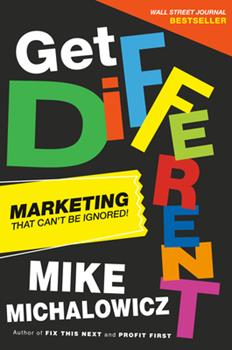Most small business owners focus on building a better product. They’d see better results by creating a differentiated product. Different is better when it comes to products and services in competitive verticals. It’s why one of my first tasks when working with small business owners is to help them develop a point of differentiation (POD). I came around to this way of thinking a decade ago after listening to well-known business consultant Michael Michalowicz discuss olympic swimmers in comparison to 23-time gold medalist Michael Phelps.
The field was no match for Phelps, said Michalowicz, so the best way for them to have garnered significance would have been to do something novel, different, like, say, dive into the pool in a creative way that caught attention.
“What if one of the Olympic swimmers did a cannonball into the pool instead of diving?” wrote Michalowicz. “He’d probably lose, but he would get noticed. And we’d remember him, too—likely forever, as he would be immortalized in every ‘memorable moments in Olympic history’ video montage until the end of time.”
How do you make different work for your brand?
At least once per week, I get a call from someone who wants to know my thoughts on their Internet business or idea. Often the idea is still in the development stages, with more work to be done, but the person on the other end has a clear vision that it will serve a specific segment of the market and become a whirlwind success. Just as often, though, are the folks who ask my opinion of their existing products or services, many of which have all of the features you’d expect of a successful endeavor, but—as is the case with those pitching nascent products—they have yet to answer an important question.
How is it different?
My questions (and the answers that follow) are always the same:
Them: “Hope you’ve had time to look over my (product or service). What are your thoughts?”
Me: “I like what I’ve seen (or read), but how is it different from dozens of other similar (products or services)?”
No matter what they say, or have come to believe, their products or services are not, in any significant way, different. Which is a problem. A very big problem. One of the first steps to creating a successful business is defining your brands’ point of differentiation (POD)—that is, how your business is different, in a meaningful, significant way that prospects and customers care about, from all the others occupying a similar position?
Determining your brand’s POD is a first-order priority because without it, your business is but one in a sea of me-too products and services. Maybe most important, defining a POD gives business owners the ability to really hone in on a product or service that could meet demand of an under-served audience or market.
What I find is that most companies have at least one person who recognizes the need for having a POD, but few understand exactly what it is, and even fewer understand how to go about establishing it.
How to identify your point of differentiation
Using the example of a new website and email newsletter, POD can be determined along the following lines:
- Features (e.g., colors, texture, navigation, logo, etc.)
- Content (e.g., blogs, ebooks, videos, white papers, guides, etc.)
- Audience (e.g., consumers, business-to-business)
- Format (e.g., text, audio, video, etc.)
- Revenue stream (e.g., membership, subscriber fee, etc.)
When I started a members-only newsletter in 2011, I knew I did not want to do what everyone else was doing. I spent weeks researching the market, the audience, and the available offerings to come up with my main PODs:
- Exclusive content,
- Service to the trade,
- Newsletter format, and
- Premium subscriber fee
The list above is by no means exhaustive; instead, it serves as a jumping-off point, if you will, to get the process started. I say that mainly because determining your POD is not entirely up to you. It’s just as much about the competition and the market you’ll be serving as it is about your business.

The role of competition in differentiating your product or service
You’ve heard the saying that “To be successful in business you need to do better at what the competition already does well.” If you’ve been reading my blog, you know how I feel about “better.” It’s far too vague, often insignificant and places your business at the whims of the market. No, as Michael Michalowicz makes plain, “It’s better to be different than to be better.
One of the simplest and most often used means of ascertaining POD is to use the old 1-2-3 model:
- Define your competition;
- Define the ways you are similar;
- List the differences.
Simple, right? Well, it’s too simplistic for my taste.
My central dislike of going down this path is how easy it is to focus only on select competitors instead of recognizing all significant competition. I also don’t trust that the folks inside the company are best able to honestly assess similarities and differences, especially in light of the fact that it’s tough to be objective when you are too close to the project.
How to determine your POD
For my money, the best way to ferret out points of differentiation (POD) is through interviews with customers and potential customers. I know a lot of folks like to resort to fancy polls and such, and doing so is easy in today’s electronic world. But one of the pieces of professional advice I ever received came from publishing consultant John Brady, who years ago advised me against trusting polls when making business decisions. Instead, he said, interviews were a much better, more accurate choice.
Here’s how to do it:
Reach out (via email and phone) to a few dozen potential customers who are already customers of your competition. Ask them 15 to 20 prepared questions, which might include:
- Likes/dislikes of the competition’s site;
- What they would change;
- What features they access most;
- How much time they spend on the site;
- Which features they’d prefer to see in a similar site;
- What would a competing site need to have to pull them away.
The list could be endless, but I’d try to keep the questions under 20 or so. Also, keep in mind that consumers are often poor judges of what they want until they’ve seen it, so I’d refrain from asking questions meant to judge things they’ve yet to experience (e.g., features your site might have but that they have never come into contact with).
The ultimate goal in determining a POD is not to define the features that set you apart from the competition. Rather, it is to determine the features that set you apart and that resonate most with your core market.
Tying it all together
In his book “Get Different: Marketing that cannot be ignored,” Michalowicz shares what he calls three critical questions every entrepreneur and business owner must ask about their marketing:
- Does it differentiate?
- Does it attract?
- Does it direct?
Answering these questions places you well ahead of the competition. In part because by doing so you’re able to focus on the differentiation that gets you noticed, attract the right customers, and nudge them to take the action you most desire: convert, become a customer. By following these steps and the others outlined in the post, you’re positioning your brand leaps and bounds ahead of the competition, most of whom will still be stuck focused on best, not different.





